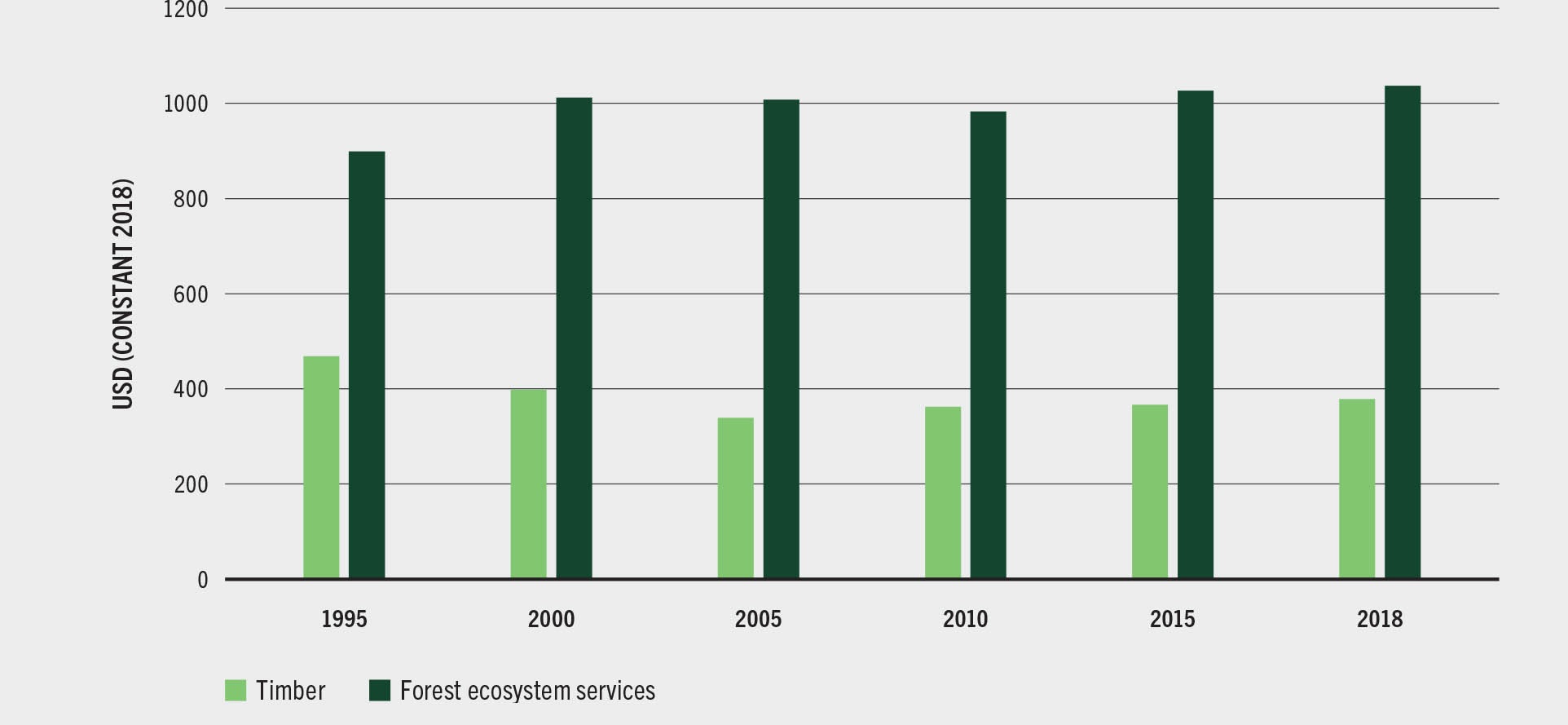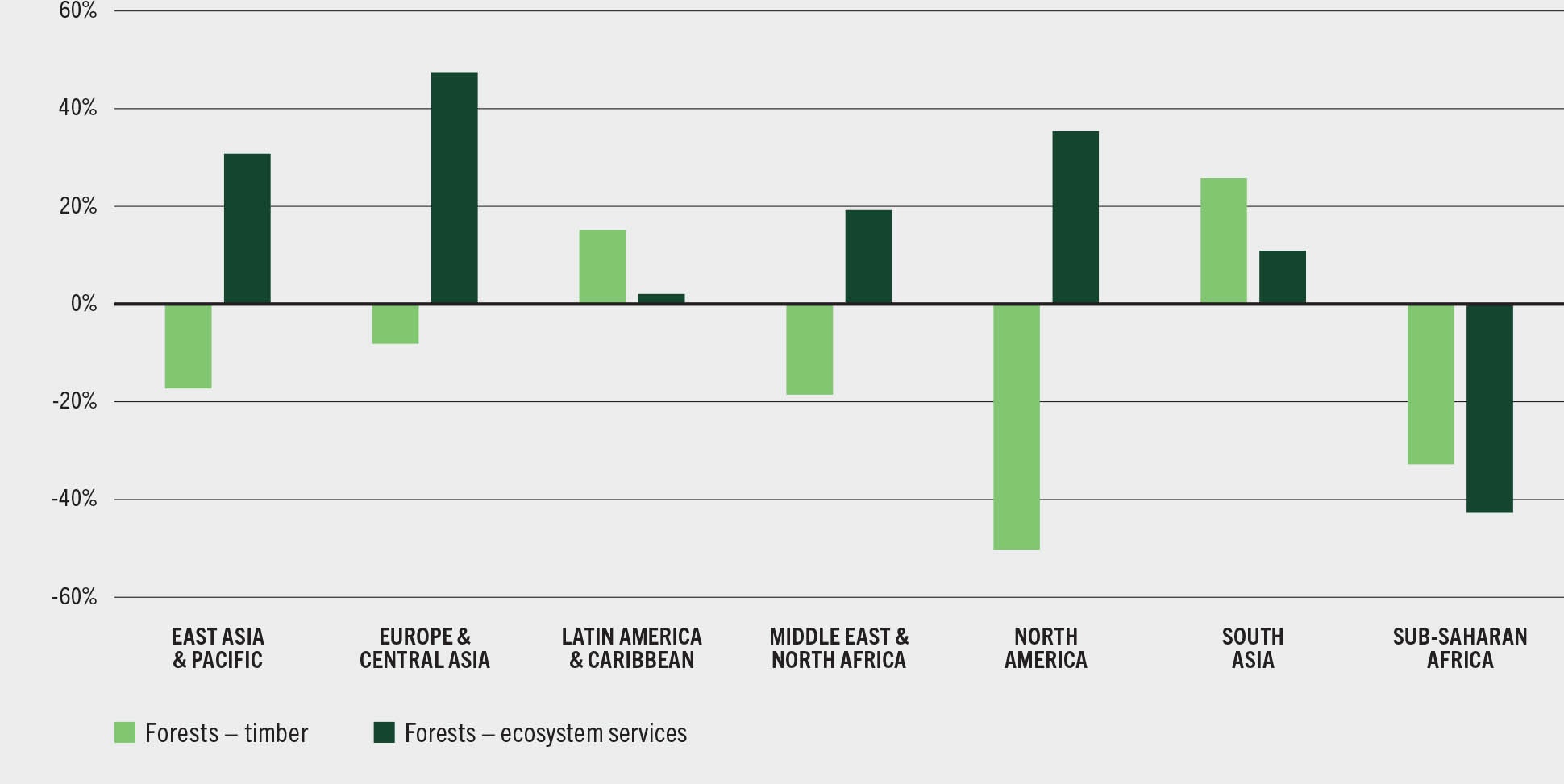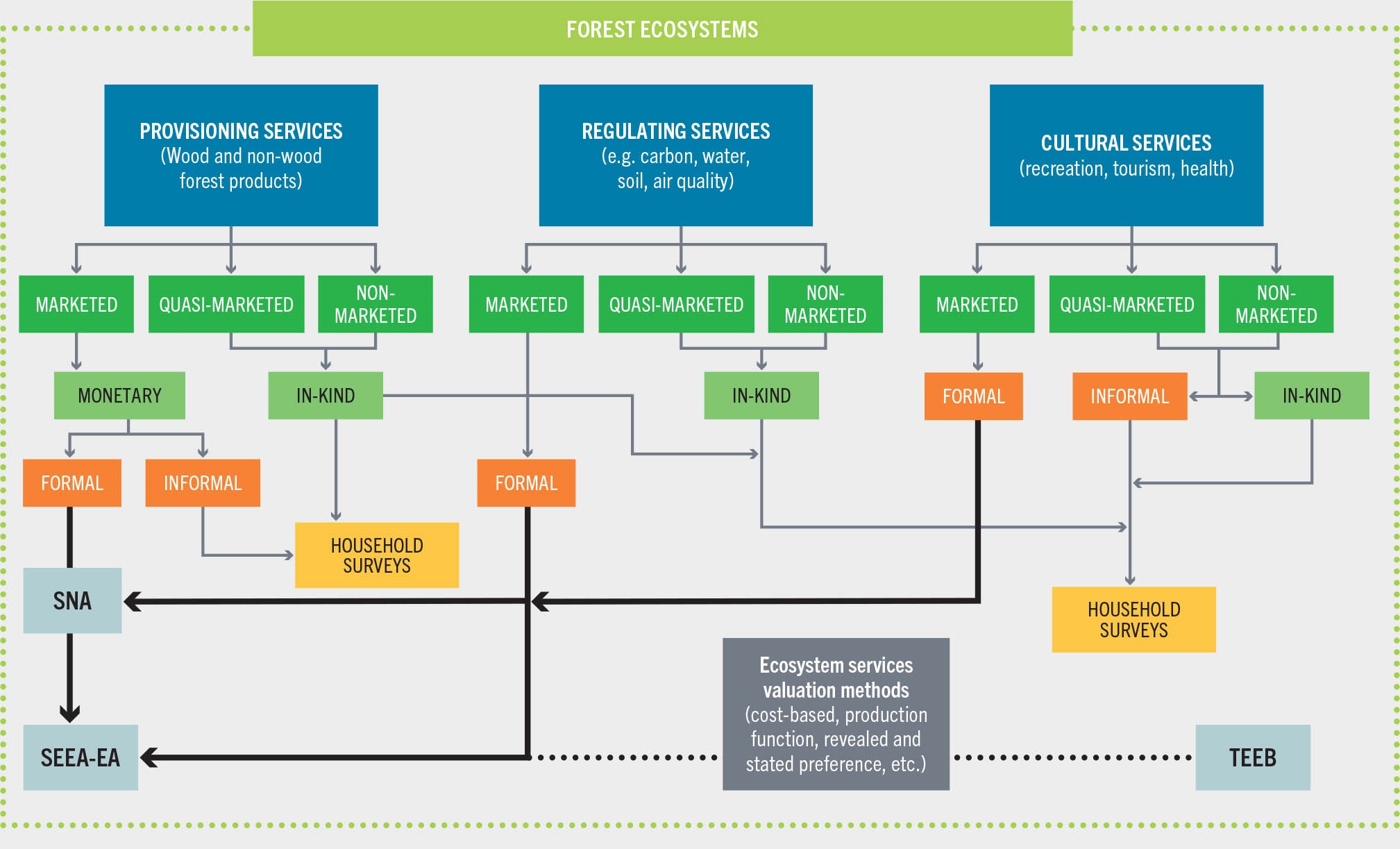The estimated value of a subset of forest ecosystem services was USD 7.5 trillion in 2018, but forest wealth per capita has decreased in low- and middle-income countries
The wealth represented by certain forest ecosystem services (recreation and hunting, habitat, non-timber forest products and water services, excluding timber and carbon) is estimated to have increased from USD 5 trillion in 1995 to USD 7.5 trillion in 2018, which is 21 percent of the total wealth in land assets (comprising cropland, pastureland, forest timber, forest ecosystem services and protected areas).47
Forest timber wealth per capita declined between 1995 and 2005 (Figure 4), with reductions in all regions except Latin America and the Caribbean and South Asia (Figure 5); this measure increased between 2005 and 2018, however. Forest ecosystem services wealth per capita increased by about 15 percent between 1995 and 2018, with increases in all regions except sub-Saharan Africa.48
Figure 4Forest ecosystem services wealth per capita, 1995–2018

SOURCE: Authors' elaboration based on World Bank. 2021. The Changing Wealth of Nations 2021 – Managing assets for the future. Washington, DC. https://doi.org/10.1596/978-1-4648-1590-4. License: Creative Commons Attribution CC BY 3.0 IGO
Figure 5Percent change in forest ecosystem services and timber wealth per capita,
by region, 1995–2018

SOURCE: Based on World Bank. 2021. The Changing Wealth of Nations 2021 – Managing assets for the future. Washington, DC. https://doi.org/10.1596/978-1-4648-1590-4. License: Creative Commons Attribution CC BY 3.0 IGO
In low- and middle-income countries, forest wealth per capita (i.e. timber plus the three indicated forest ecosystem services per capita) decreased by 8 percent in 1995–2018 due to a combination of population growth and the loss of forest area. Also in low- and middle-income countries, wealth per capita in croplands and pasturelands increased by 9 percent between 1995 and 2018 due to area expansion and an increase in value per unit area. Many low-income countries, particularly in sub-Saharan Africa, experienced declines between 1995 and 2018 in their wealth per capita in land assets.49
It is estimated that more than half of world gross domestic product (GDP) (USD 84.4 trillion in 2020) depends moderately (USD 31 trillion per year) or highly (USD 13 trillion per year) on ecosystem services – including but not limited to those provided by forests.50 In addition, certain major sectors, such as travel and tourism, real estate, and retail, have hidden dependencies on ecosystem services through their supply chains.51
Attempts are underway to generate more reliable and comparable estimates of the economic value of nature
Timber, woodfuel and various forest fruits, resins and other non-wood products have markets of local, national and international significance, generating income, employment and production values that are captured in national registries and accounting systems. Despite recent efforts to broaden the international classification of forest products to encompass non-wood products,52 however, reporting on these is still insufficient to enable robust quantifications of forest production. Accounting for the benefits to society provided by forest ecosystem services is even more challenging, given the general lack of markets for them (and those that do exist, such as for water and carbon, are at incipient stages).
The absence of natural asset stock such as forests in national asset/wealth accounting risks serious errors in policy decision-making, with a decline in natural assets likely to affect other assets in the longer term. It is unlikely that any national economy will be able to maintain current levels of wealth and well-being if climate change and natural-asset destruction continue at the current pace. Understanding the magnitude and importance of natural assets is essential for the design of policies and instruments aimed at achieving sustainable development and for identifying investment and income-generation opportunities and risks.
The adoption of the System of Environmental-Economic Accounting (SEEA) Ecosystem Accounting (EA) provides a means to increase tracking of the national value of nature and generate more reliable and comparable estimates. The SEEA-EA is a necessary complement to the System of National Accounts (Figure 6) – the latter summarizes national economic transactions and registers the relationship between the main national macro-economic aggregates, leading to the calculation of the most recognized economic measurement of the national economies, GDP, but it is limited to the accounting of products and services with significant market transactions. More concrete possibilities for trade, compensation and payments for all ecosystem services will likely emerge as countries advance in the use of the SEEA-EA.
Figure 6The relationship between the System of National Accounts and the System of Environmental-Economic Accounting – ECOSYSTEM Accounting in the valuing of forest ecosystem services

SOURCE: FAO.
FAO and the Foundation for Sustainable Development recently updated the Ecosystem Services Valuation Database (ESVD).51 The aim was to produce value estimates for all forest ecosystem services in nine forest ecosystem types and mangroves (the latter defined in the SEEA as a transition ecosystem), as per The Economics of Ecosystems and Biodiversity and the SEEA classifications, and to increase the representation and geographic coverage of forest ecosystem services. By collating data from existing literature, the ESVD provides an overview of data availability on the values of ecosystem services from forest biomes. Comparing values across biome types is possible, with the qualification that information is incomplete and also more readily available for some biomes than others.
The ESVD presents mean values for ecosystem services by forest ecosystem type and indicates the magnitude of values and the coverage of the available data. There is considerable variation in estimates of ecosystem services across forest types, with very high values for some ecosystem services. For example, mangroves have high mean values for the provision of food (by supporting adjacent fisheries) and the moderation of extreme events (by mitigating coastal flooding). Urban parks and forests have high mean values for air-quality regulation and recreation, with a total value of just over Int$ 400 000a per ha per year.53 National parks and protected areas generate considerable economic opportunities, as shown by recent growth in nature-based tourism (Box 2).
Box 2The economic importance of nature-based tourism
Before the COVID-19 pandemic, protected areas globally received roughly 8 billion nature-based tourism visits annually, generating about USD 600 billion per year in direct in-country expenditure; in addition, the “consumer surplus” (which measures the economic value of the environmental benefit to the visitor) was estimated at USD 250 billion per year.55 In Finland, data on national park visitations have been collected systematically for 20 years, and the impacts of revenue and employment on local economies have been assessed since 2009. The data show that local economic benefits are considerable: the total impact of all 40 national parks in Finland on income and employment in 2019 was estimated at EUR 219 million and about 1 726 jobs (full-time equivalent). The biggest local economic impacts were in tourism centres, where visitors stay longer and where there is a good supply of tourism services. According to Metsähallitus, which manages national parks in Finland, the local benefits are tenfold compared with public investment in the areas.
SOURCE: M. Kniivilä and L. Tyrväinen, Natural Resources Institute Finland, personal communication, October 2021.
The values presented in the ESVD show that diverse combinations of forest ecosystem services can support many strategies for a resilient and more equitable planet. For example, based on the information available, tropical forests are equally valued for their provisioning and regulating ecosystem services (at 47.3 percent and 49.3 percent of the total value of ecosystem services for these forests, respectively). In contrast, temperate forests are equally valued for their regulating and cultural values (42.6 percent and 44 percent, respectively), and high mountain forests are overwhelmingly recognized for their regulating services, which account for about 87 percent of their attributed value.54


